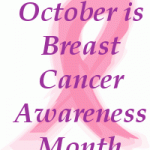Breast Cancer Awareness Month
October 1, 2011 by USA Post · Comments Off on Breast Cancer Awareness Month
 Breast Cancer Awareness Month, Doing it in the shower. Do while preparing for bed. Only do it once a month. Get familiar with your breasts. Look for lumps, changes in the size, shape or feel, and to see if there is any fluid.
Breast Cancer Awareness Month, Doing it in the shower. Do while preparing for bed. Only do it once a month. Get familiar with your breasts. Look for lumps, changes in the size, shape or feel, and to see if there is any fluid.
All women should know their breasts and their surroundings in order to be aware of the changes, the American Cancer Society.
“I encourage everyone to become an expert on how your breasts look and feel so you can detect subtle changes. After all, our bodies, which are the ones who have to live with what goes wrong with it, “Yoon said Jennie Buchanan, Medical Director of Services for Women Image in Florida Hospital.
It is even more important for women in their 20 years to see a doctor for a clinical breast exam every three years – and every year after age 40. Most physicians recommend annual mammograms for women over 40 years. Increased risk women and men should see their doctors more often.
“Many breast cancers found in women who never felt a lump, because on average, mammography detected 80 to 90 percent of breast cancers in women without symptoms,” said Kristin Thomson, executive vice president, provisional, American Cancer Society of New York and New Jersey.
“In New York, more than 5,100 women will be diagnosed with breast cancer this year,” he said.
In the state, experts predict 15,570 new breast cancer cases diagnosed this year.
October is Breast Cancer Awareness Month, and the idea is to educate women and men and to raise money for the cure. Sometimes women are afraid to go to the doctor, but this is the time to do it. Invite your friends and make appointments.
The American Cancer Society works closely with the departments of health and health systems to offer free mammograms. Call 1-800-227-2345 for more information.
Advances in medicine are diagnostic innovations, such as those found in New York-Presbyterian Hospital. The hospital is working on early detection procedures are less invasive than.
“The improvements in detection and knowledge about surgical treatment options and outcomes, have been increasingly longer lives and better for women with breast cancer,” said Dr. Andrew Seidman, who works New York and is part of the American Society of Clinical Oncology.
Are you a survivor? Do you have a story to share? Patch wants to give you a place to inspire and encourage others. Send us your pictures of the 5 km race parties, pink, dog walks and lunches. Heading to get a mammogram with her friend, sister, coworker or child? Take a picture before you go, and send it our way!
Breast Cancer Awareness Month
October 1, 2010 by Post Team · Comments Off on Breast Cancer Awareness Month
 Breast Cancer Awareness Month, Breast cancer continues to take a heavy toll on American women, 26 years after health advocates called October Awareness Month National Breast.
Breast Cancer Awareness Month, Breast cancer continues to take a heavy toll on American women, 26 years after health advocates called October Awareness Month National Breast.
How big a toll? In 2006, 191,410 women were diagnosed with breast cancer and 40,820 women died, according to latest statistics from the Centers for Disease Control and Prevention.
Breast cancer is the second most common cancer in women, after nonmelanoma skin cancer.
But the news is not all bad. In fact, women live longer than ever after a diagnosis.
“There has been a decline in mortality over the past 40 years,” says Dr. Deborah Axelrod, director of clinical programs and services for breast cancer at New York University Cancer Institute at NYU Langone Medical Center in New York. “We have made cancer a chronic disease. I’m optimistic.”
Here’s something else you know. Men get breast cancer too, although much less frequently than women. For every 100 cases in women, a man has breast cancer, according to the CDC.
What steps can be taken to reduce risk? Regular exercise and weight control can help, experts say. So you can limit the amount of alcohol you drink.
regular mammograms may be helpful too. But it is also important to know the warning signs of breast cancer.
These include:
* New lump in the breast or underarm (armpit).
* Thickening or swelling of part of the breast.
* Irritation or dimpling of breast skin.
* Redness or scaling of the nipple area or chest.
* Sinking of the nipple or pain in the nipple area.
* Nipple discharge other than breast milk, including blood.
* Any change in size or shape of the breast.
Pain in any area of the breast.
If you want to help raise money for the cause, there are plenty of events this month across the country. Here’s a short list.
And stay tuned at CBSNews.com. We have a lot of edging is cut over the next few days, including breast cancer myths debunked, what you need to know about mammograms and a step by step guide to self-examination.



